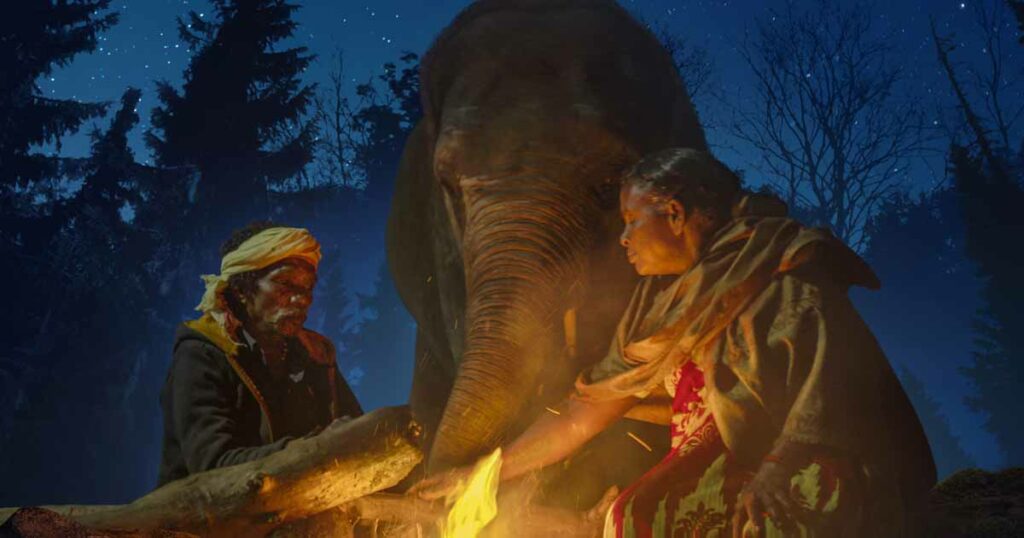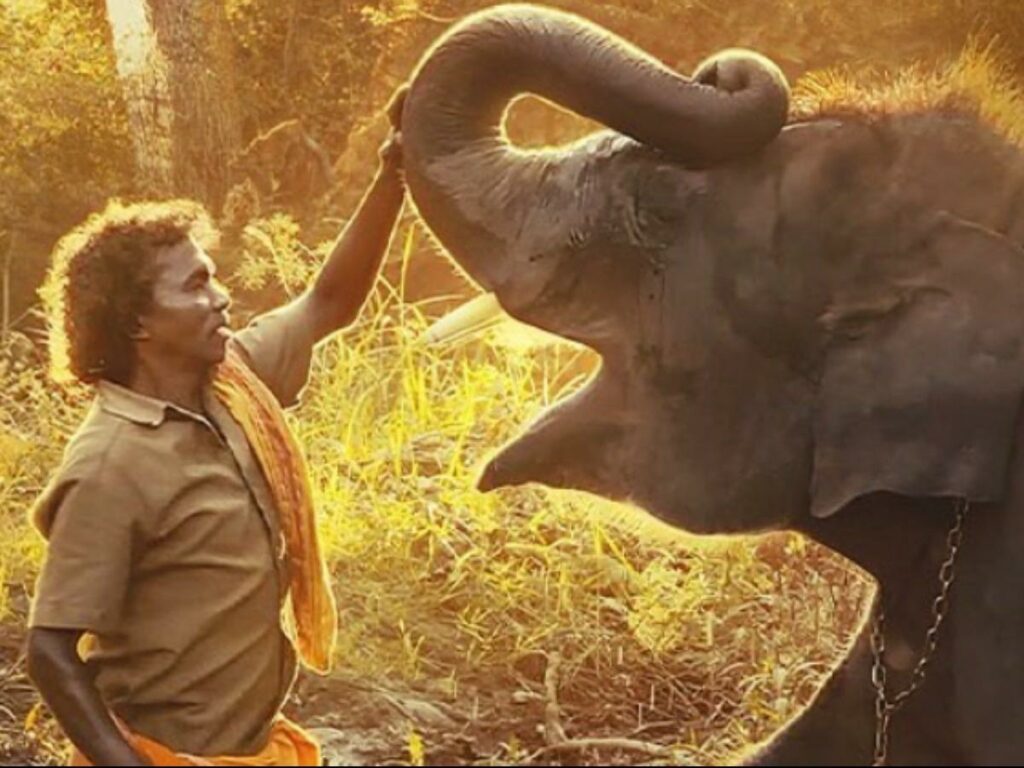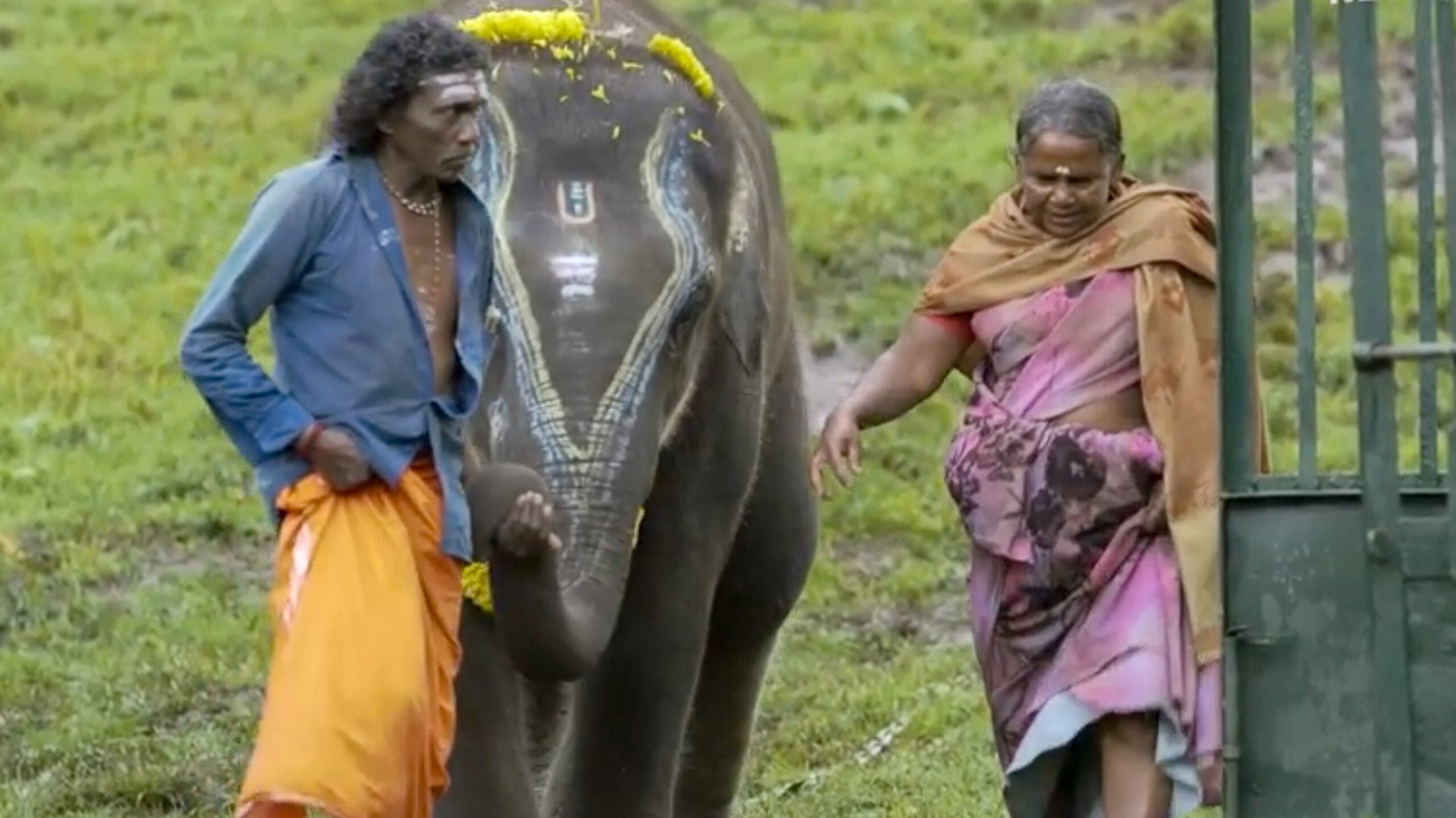Kartiki Gonsalves’ win at the Oscars has been a pioneering plume to Indian cinema’s cap and its struggle to get international recognition and acceptance. Academy cutting off Guneet Monga’s speech felt like a denied opportunity to respect her years of persistent support and contribution to Indian cinema. But the voices missed and most remembered, as the makers climbed the stage, were that of Bomman and Bellie, Raghu and Ammu.
Elephant Whisperers documents the story of Bomman and Bellie from the Kattunayakan tribe, traditional dwellers of the Mudumalai forest, and their journey with two elephants – Raghu and Ammu. The story runs in a linear narrative – with Bomman taking the viewer into the forest to their home in the Theppakudu Elephant Camp, in the Mudumalai National Park (Tamil Nadu). Thereafter unfolds a small portion of their lives as elephant caregivers.
Elephant Whisperers is a brief peak into the incredible relationship of the forest with its people and animals – tied together with care and love. And the tragic fate of pain, aggravated by the clinical hands of the civilised and the urban. The film documents many moments of tenderness, mischief and love, but does it summarily fail to voice the conflict and pain of the forest?

Elephant Whisperers documents the story of Bomman and Bellie from the Kattunayakan tribe, traditional dwellers of the Mudumalai forest, and their journey with two elephants – Raghu and Ammu. The story runs in a linear narrative – with Bomman taking the viewer into the forest to their home in the Theppakudu Elephant Camp, in the Mudumalai National Park (Tamil Nadu). Thereafter unfolds a small portion of their lives as elephant caregivers. Baby elephants separated from their herds have a difficult time surviving.
Even rescuers and caregivers have a hard time saving them. Bomman and Bellie are a couple of such caregivers who have been successful. The film opens with Bomman saying “I am Kattunayakan”, which roughly translates into king or lord of the forest. The term “lord” or “king” have become symbols of oppression and arbitrary rule. But what Bomman and Bellie share with the audience is the knowledge of what lords or rulers have always been – in service of their land.
Also Read: On Turning Twenty and The Oscar Story – Khabar Lahariya Has A Few Things To Say
The film is a saga of love and care, peppered with mischief. Bellie, not an official forest staff as a caretaker, was assigned to work with Raghu, employed by the forest department, to take care of Raghu – a rescued baby elephant. Yet their story subverts this hierarchy of rescue as it unfolds through the film. They save the elephants and the elephants save them right back. While taking care of Raghu, Bomman and Bellie spends time with each other. It is not clear how and when their love grew but through the film, we see them get married. It is evident that their relationship strengthened with Raghu taking the centre stage.
The tribal community’s relationship with the forest is so symbiotic that care or rescue does not become a language of colonisation or supremacy. Bellie mentions how Raghu learnt from his own kind ways to avoid the thorns when grazing and how some knowledge systems exist within the boundary of a species. She also mentions how she is afraid of the forest but that her people come from the heart of the forest, and understand and respect it.
Later as baby Ammu, the second orphan elephant is assigned to them – Bomman mentions how they had become a complete family. Bellie, widowed by a leopard, had lost her daughter recently when she was tasked with taking care of Raghu. He becomes her pillar of comfort – she grieved with him and loved him like her lost child.
The tribal community’s relationship with the forest is so symbiotic that care or rescue does not become a language of colonisation or supremacy. Bellie mentions how Raghu learnt from his own kind ways to avoid the thorns when grazing and how some knowledge systems exist within the boundary of a species. She also mentions how she is afraid of the forest but that her people come from the heart of the forest, and understand and respect it. The well-being of the forest is of utmost importance to them. This simple knowledge has somehow eluded human urbanisation that the well-being of the forest ensures everything, which includes our own sustenance.
This story could easily take an intensely grim turn but what breathes an air of freshness is the mischief of all the characters – humans and elephants. Bellie jibes at Bomman at every moment the camera finds the lovebirds alone. She giggles about Bomman biting off her fingers if she fed him. Elephants in the rehab chase roosters around while Raghu plays football with Bomman. There is a lightness in the language shared by each character in the camp. The story of interdependence and cohabitation is half told in this documentary.
Half an hour into the film Bomman, Bellie and Ammu suffer separation from Raghu, as the forest department reassigned him to another family. Bomman’s eyes shine with tears as he recounts how he begged the officials not to take Raghu away. Raghu was successfully brought up by them. Their reward was separation because humans have evolved to become maximisers and they see people like Bomman and Bellie as successful rescuers and caregivers who need to be free to take up another elephant calf when the time comes.
The langurs run as a beautiful parallel story to that of the elephants. The balls of millet that Raghu refused to eat become feed for the langurs. The langurs, who also live in the commune system, hanging around with their babies nestled against their bodies reminds you of the relationship of care and love that runs across species. The cohabitation of different species should not have been a pipe dream but a natural order of things. A recent report revealed that the total weight of wild mammals is less than 10% of humans. Elephants are in dire crisis as urbanisation has caused habitat loss to the largest animal on land. They also pose a threat to human communities that do not understand their ways and temperament. The documentary brings a much-needed focus on tribal knowledge and capacities that can find better solutions and knowledge of cohabitation.

While emotions tenderly wash the film with joy, love and care – cruelty is softened and injustice is left behind the curtains. Half an hour into the film Bomman, Bellie and Ammu suffer separation from Raghu, as the forest department reassigned him to another family. Bomman’s eyes shine with tears as he recounts how he begged the officials not to take Raghu away. Raghu was successfully brought up by them. Their reward was separation because humans have evolved to become maximisers and they see people like Bomman and Bellie as successful rescuers and caregivers who need to be free to take up another elephant calf when the time comes.
Also Read: Oscars 2020: Why Are #OscarsSoMale & #OscarsSoWhite
The urban or governmental powerheads fail to recognise what needs help and support. The tribal knowledge, love and care of the forest need conservation. The people who are spending their time, labour and love to bring up orphaned calves are not tools of conservation but teachers. There is also a failure in understanding the support system and community created through the bond between animals. The film successfully captures that loss which cannot be humanly articulated – as Ammu cried out for Raghu when he left their camp. In these emotional injuries, the bureaucratic “rulers” of the land reveal how myopic and clinical their vision is.
In a recent relocation drive 569 families from Kattunayakans, along with Irula, Paniya and Kurumba tribes, were moved out of the Mudumalai tiger reserve. The relocation started in 2017. The film that so optimistically shows young kids washing elephants as the elephants shower them with water – hides away the stories of rot under cheer and sunshine. The relocation drive promised a fair sum of money to each family but after relocation, they realised that they were heavily compromised and cheated.
Another unexplored story is of the women who are kept on the sideline of this work. Bomman mentioned at the beginning of the film how Bellie was the only woman assigned to care for baby elephants. As we see through the film Bellie plays the role of an equal in bringing up Raghu and Ammu. One would expect that eventually she would have been officially inducted as a permanent staff member.
A resident that the officials tried relocating says, “Neither us nor the forests have benefitted from our relocation. Only a few Forest Department staff and some middlemen have profited from the funds meant for us.” Even Bommon and Bellie are not in the same camp anymore as the former was tasked with taking care of two orphaned elephant calves in Dharmapuri, more than 170 miles away from Mudumalai.
While India celebrated their story at the Oscars, Bommon was awake through the night taking care of the two calves crying for their dead mothers. At the moment they are lost and Bommon is out on a mission to trace them.
Another unexplored story is of the women who are kept on the sideline of this work. Bomman mentioned at the beginning of the film how Bellie was the only woman assigned to care for baby elephants. As we see through the film Bellie plays the role of an equal in bringing up Raghu and Ammu. One would expect that eventually she would have been officially inducted as a permanent staff member.
Even though they have moved on to Dharmapuri, Bellie can still visit Raghu and Ammu. But Bellie is hurt and the distress is evident, “After stopping me from taking care of the two, they are asking me to cuddle with the elephants. How can I do that? It is incredibly distressing for me and the elephants to be close after the period of separation.” The film has driven the Tamil Nadu government to the immediate action of felicitating Bomman and Bellie, and now the makers. But the action that this film should initiate is to reconsider how the forest department functions and find a collaborative solution with the tribal people of the forest.
Also Read: The Oscars Did It Again! It Chose To Overlook The Women Directors
The film is encased in beautiful and classical cinematography. The Nilgiris with its waterbodies becomes a playground for magic and romance. Gonsalves’ expertise in wildlife photography shines through. The comfort that the elephants felt around the cameras and the team was evident. The many secret moments and small gestures amongst Bellie, Bomman, Raghu and Ammu are carefully noted by the camera. Led by her, the cinematography team also captured some stunning snippets of animals, other than the protagonist elephants, walking or perching in the interiors of the forest. But these neatly captured shots, fit for a nature documentary, are stitched to the central story in no particular order. It lacks the care and intimacy that the director probably aimed to showcase – the ecosystem of Mudumalai that is both gentle and fierce.
There is a lot to celebrate about the story of Elephant Whisperers. Some are reaching the Mudumalai reserve to track down Raghu and Ammu to click the all-important selfie. There is so much hope with which the film ends. It makes a viewer feel good as the screen goes blank, but for whom is the pain reserved? Every documentary has its own purpose and pain is indeed uncomfortable to sit with. In many ways, the documentary serves the purpose of instilling hope and takes its viewers through an emotional journey that teaches about radical care, love and community.
A cheetah climbs down a green thatch, a bear walks through grass or a vulture perches high on a tree. Their stories, in the context of Bomman and Bellie, should have been more than fillers. In one successful instance, the film shows a queue of women parading Bellie to the temple for her wedding as two deers looked on. A beautiful moment of animals casually witnessing human rituals. The light in the reserve is enchanted but the lack of natural sound removes the viewer from the heart of the visual. The opening promises that the sounds of the forest will embrace us as the water running against Bomman’s legs whispered and gurgled. But most of the film keeps the viewers outside that threshold. The sound design was in need of more diegetic sound of the forest. The music aids in places but majorly feels too heavy and mawkish.
Special mention – the two trunks! Raghu and Ammu’s trunks emoted and expressed so casually. From Raghu mischievously tearing off the garland’s flower during Puja to eat it, to Ammu wrapping her trunk around Bomman’s wrist – asking for comfort, to Raghu wiping Bellie’s tears – the trunks were the star performers and also a testament to the emotional intelligence of elephants.
There is a lot to celebrate about the story of Elephant Whisperers. Some are reaching the Mudumalai reserve to track down Raghu and Ammu to click the all-important selfie. There is so much hope with which the film ends. It makes a viewer feel good as the screen goes blank, but for whom is the pain reserved? Every documentary has its own purpose and pain is indeed uncomfortable to sit with. In many ways, the documentary serves the purpose of instilling hope and takes its viewers through an emotional journey that teaches about radical care, love and community.
But it fails to point the viewer to the direction of decay – where all things uncomfortable lie. Hopefully, viewers of Elephant Whisperers will switch tabs and start reading about the current condition of the Kattunayakan tribe or the Asian elephants. There is so much knowledge of the original inhabitants and lords of the forest that is slipping through our fingers as self-fashioned “lords” of the land meet at global summits. The documentary successfully initiates a wake-up call to search for the problem.
About the author(s)
She/they is an editor and illustrator from the suburbs of Bengal. A student of literature and cinema, Sohini primarily looks at the world through the political lens of gender. They uprooted herself from their hometown to work for a livelihood, but has always returned to her roots for their most honest and intimate expressions. She finds it difficult to locate themself in the heteronormative matrix and self-admittedly continues to hang in limbo





This movie has brought actual feeling to the real world where people are so selfish for their own benefits that they won’t spare such a lovable and helpful animal, Hope this will be helpful